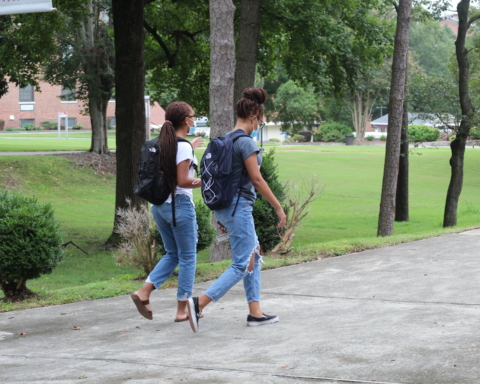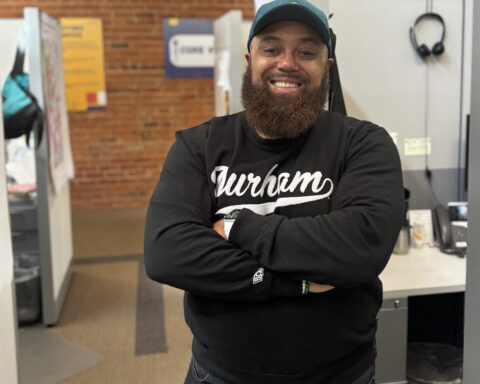Most rivers that surged to flood levels in North Carolina this week are beginning to subside, but many remain at major flood stage and some are expected to rise again over the next several days.
Despite the receding rivers in some places, major flooding remains along the rivers in Fayetteville, Hookerton, Pembroke, Kinston, Goldsboro, Burgaw, and Tomahawk, state Emergency Management Director Mike Sprayberry said at a briefing Thursday.
“Recovery is beginning in many places,” Gov. Roy Cooper said at the briefing. “But for some communities, today is still a matter of life and death.”
The storm-related death toll rose to 41, including 31 in North Carolina.
Cooper said 4,700 people have been rescued, twice as many as in Hurricane Matthew in 2016.
On Thursday, the Cape Fear River at Fayetteville dropped to 59.49 feet from 61.58 feet on Wednesday — almost 27 feet above flood stage but not enough to inundate the downtown district, according to The Fayetteville Observer.
The Neuse River in Goldsboro was at 26.66 feet, down from 27.6 feet but far above the 18-foot flood stage. The Northeast Cape Fear River at Burgaw dipped from 25.55 to 25.19; flood stage is 10 feet.
Robeson County has been reporting that gauges on the Lumber River have not been working accurately. Officials there estimate the river crested at 25 feet on Monday night and they are expecting a second crest of 24 feet over the weekend. Flood stage on the Lumber is 13 feet.
Health warnings
The threat of illness from overflowing and polluted rivers and streams across southeastern North Carolina will not subside when the waters recede. Mosquitos, wounds to those without current tetanus vaccines, and digestive problems from coming into contact with flood water are some of the health risks.
The state’s public health director, Betsey Tilson, is warning people who live near flooding to avoid the water because it could be contaminated with human waste from septic tanks, animal waste from farms, and agricultural pesticide runoff. Breached and spilling hog waste lagoons are contributing to the problem.
“People should always assume that flood water is always contaminated,” Tilson said.
Rachel Noble, an environmental microbiologist at UNC-Chapel Hill, said fecal coliform bacteria can survive in the current water conditions for weeks or longer.
The state Department of Health and Human Services on Wednesday put out a call for physicians, nurses and behavioral health professionals to volunteer their services.
Roads still blocked
Roads are improving slowly, but state officials are still discouraging people from driving to southeastern North Carolina because of submerged or damaged roads. Large sections of Interstate 40 and Interstate 95 remained impassable.
U.S. 70 Bypass closed at Kinston on Thursday afternoon. It had been open from the Triangle to the coast, but high water forced officials to close it.
Eastbound traffic filled with displaced people trying to return home, such as on U.S. 421 between Clinton and Wilmington, and the State Highway Patrol is warning drivers that the two-lane highway is becoming overwhelmed. Drivers could be stuck in that traffic for hours, New Hanover County Emergency Management officials said late Wednesday.
On Thursday morning, state transportation staff closed U.S. 421 again at the Pender-New Hanover county line where it crosses the Northeast Cape Fear River. Rising waters covered the highway and it wasn’t clear when it would reopen.
The U.S. Department of Transportation announced Thursday afternoon that it will immediately release $14 million in emergency money to get used to help restore roads and bridges. The agency said it was an initial installment of funds.
N.C. Transportation Secretary Jim Trogdon said there were 16 flooded sections on interstates, down from 19 over 48 hours. Most of the flooded-out sections are on I-95 and I-40.
He said 32 U.S. routes and 134 primary routes were closed due to flooding. Trogdon estimated that I-40 might be cleared the weekend after the upcoming one. In general, he said, it could take a week to clear a road after nearby rivers have crested.
Disaster office flooded
One coastal community hit by the storm, Emerald Isle, has posted drone video footage on its website so that displaced residents can see if their houses were damaged.
Emerald Isle reported most houses had relatively minor damage, but there were numerous trees downed and roads blocked.
Robeson County said World Central Kitchen — founded by celebrity chef Jose Andres — and the Haiti Relief Organization planned to distribute about 640 hot meals Thursday afternoon in Lumberton.
The Robeson County disaster recovery offices were flooded, so temporary quarters have been set up at the African American Cultural Center at 123 W. 3rd St. in Lumberton. Supplies such as flashlights, masks, gloves, water bottles and tarps were being handed out Thursday.
‘They want to go home’
Cooper is continuing his daily tours of damaged neighborhoods throughout that part of the state, beginning Thursday at the Lumberton Emergency Operations Center. The governor met volunteers at the Hyde Park Baptist Church in Lumberton and surveyed storm destruction near the Little River in Fayetteville. Cooper wrapped up the day with the news media briefing in Raleigh in the evening, noting it was the 13th day of a state of emergency.
He said about 6,000 people are in shelters.
“They really want to go home,” Cooper said. “Some of them don’t have homes but they are glad to be safe. Many are waiting to find out.”
The cost of storm damage will be in the billions of dollars, Cooper said.
“We will come forward with a responsible but certainly hefty package of what North Carolina needs,” the Democratic governor said.
In Washington on Thursday, North Carolina Republican congressmen George Holding of Raleigh and David Rouzer of Johnston County, along with South Carolina Republican U.S. Rep. Tom Rice, introduced a Florence tax relief bill in the U.S. House. It is modeled after legislation that quickly passed last year after storms in Puerto Rico and the mainland United States.
Story by Craig Jarvis and John Murawski with contributions from staff writer Richard Stradling and Stuart Leavenworth and Brian Murphy of McClatchy DC
News & Observer (Tribune News Service)



















